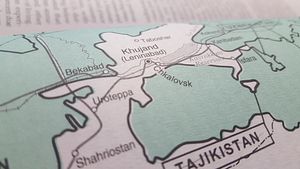An interesting marker of the passage of time and power in Central Asia is the names of cities. During the Soviet Era countless towns were renamed in Soviet style. With independence came a wave of new city names as the newly independent states sought to separate themselves from their neighbors physically, historically, and culturally.
As Farangis Najibullah reported for RFE/RL this week, in Tajikistan President Emomali Rahmon sent parliament a list of new names for several towns and districts. The new names follow a trend in which anything not distinctly Tajik or Persian in origin is dismissed. This movement on the part of Rahmon drew headlines over the past year as a bill to ban Arabic names floated around. What I wrote in early December still stands: “Sometimes a name is just a name.” But that cavalier attitude is absent from Dushanbe.
With regard to the new names, Najibullah writes that “Some will have their former Persian names restored, some will be named after historic Tajik figures, and others will be given new Tajik names.” Qairoqqum will drop its Uzbek name for Guliston (“City of Flowers”) and Ghonchi district will drop its Turkic-rooted name for Devashtich.
Tajikistan isn’t the only regional state to rename its cities, though the most notable examples happened over two decades ago shortly after the Soviet collapse and targeted cities with Soviet-esque names. Across the region, Slavic suffixes -ov were dropped from cities and surnames alike as Soviet influence receded and the need to (re)define a national identity grew in the newly independent states.
In Kazakhstan, the former capital of Almaty began life as a series of settlements but the modern city has its roots in the Russian fort called Verniy. The city was called such until 1921 when the Soviets re-named it to Alma-Ata. In 1993, the Kazakh government changed it to Almaty.
One of my favorite examples is the evolution of Bishkek’s name. In 1862, Kyrgyz helped Russians take a mud fort which had been built by the Kokand Khanate, the place was called Pishpek afterward. Pishpek was made the capital of the Kara-Kyrgyz Autonomous Region in 1925 and the next year was renamed Frunze after Mikhail Frunze, a Bolshevik general who had been born there when it was little more than a Russian garrison town. In 1991, after the Soviet collapse independent Kyrgyzstan quickly renamed its capital Bishkek (though the airport retains the IATA airport code of FRU).
Tajikistan, shortly after independence, followed a similar line targeting Soviet-origin names. The present city of Khujand had been known as Leninabad from 1936 to 1991. This latest round, as noted by Najibullah, takes aim not at Soviet vestiges but Uzbek, Kyrgyz and Turkic-sounding names. Then there’s the not-so-pretty names: “last year, the southern village of Gurgkhurda, which means Eaten by Wolves, was renamed Chamanzor, or Lush Green Place. The nearby village of Pustkhur, or Skin Eater, is now called Shohrukh, or Majestic Face. The two were among more than 50 villages across Tajikistan renamed by authorities in July.”
To paraphrase Shakespeare, what’s in a name? That which we call Qairoqqum by any other name would still be facing a devastating economic and social crisis. This is little more than a frivolous exercise for an increasingly insular and self-obsessed regime.

































